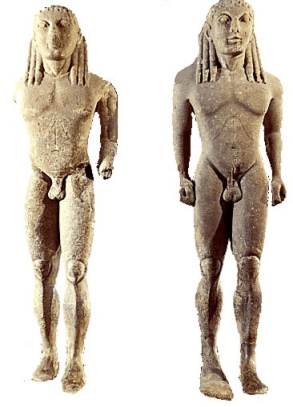.

Kleobis and Biton is the name of two figures in Greek legend. It is also the name conventionally given to a pair of lifesize Archaic Greek statues, or kouroi, which are now in the Archaeological Museum at Delphi, Greece. The statues date from about 580 BC and come from Argos in the Peloponnese, although they were found at Delphi.

Kleobis and Biton with Cydippe, Cydippe with a torch in front of the Hera Temple in Argos, the brothers dead on the ground, A Goddess takes the brothers which in the future are united again with their mother.
In Greek mythology, Biton and Kleobis were Argives, the sons of Cydippe, a priestess of Hera. Cydippe was travelling from Argos to a festival in honor of Argive Hera. The oxen which were to pull her cart were overdue and her sons, Kleobis and Biton, pulled the cart the entire way (45 stadia, or 8.3 km/5.1 miles). Cydippe was impressed with their devotion to her and her goddess and she prayed to Hera, asking her to give her children the best gift a god could to a mortal. Hera ordained that the brothers would die in their sleep, and after the feast the youths lay down in the temple of Hera, slept and never woke. Herodotus, who relates the story, says that the citizens of Argos donated a pair of statues to the sanctuary of Apollo at Delphi.
|
Kleobis and Biton from Argos, wrestlers. Herodotus writes a story about these brothers and their mother Cydippe: |
|
When Solon had provoked him by saying that the affairs of Tellos were so olbios, Croesus asked who he thought was next, fully expecting to win second prize. Solon answered, "Kleobis and Biton." They were Argive in genos, they had enough to live on, and on top of this they had great bodily strength. Both were prize-winning athletes [athlophoroi], and this story is told about them: There was a festival of Hera in Argos, and their mother absolutely had to be conveyed to the sacred precinct by a team of oxen. But their oxen had not come back from the fields in time [hôra], so the youths took the yoke upon their own shoulders under constraint of time. They drew the wagon, with their mother riding atop it, traveling 45 stadia until they arrived at the sacred precinct. When they had done this and had been seen by the entire gathering, their lives came to the best fulfillment [ariston telos], and in their case the god made clear that for human beings it is better to be dead than to live. The Argive men stood around the youths and congratulated them on their strength; the Argive women congratulated their mother for having such children. She was overjoyed at the feat and at the praise, so she stood before the image and prayed that the goddess might grant the best thing for humanity to her children Kleobis and Biton, who had given great timê to the goddess. After this prayer they sacrificed and feasted. The youths then lay down in the sacred precinct and went to sleep, and they never got up again; they remained in the pose that they had assumed in reaching their telos. The Argives made and dedicated at Delphi statues of them, since they were aristoi. |
In Book 1 of Herodotus' Histories, Solon tells the story of Cleobis and Biton to King Croesus as an example of a happy life lived, reckoning them second in happiness only to Tellus the Athenian, much to Croesus' annoyance. Herodotus records that "the Argives had statues of them made and set them up at Delphi, because they had been such excellent men". The modern Delphi Museum displays two identical Archaic kouroi under the names of Cleobis and Biton, although there is no evidence directly connecting these statues with the ones mentioned by Herodotus.
Inscriptions on the base of the statues identify them as Kleobis and Biton, and also identify Polymedes of Argos as the sculptor: something which was very unusual at such an early date. The statues are in what is regarded as a typical Peloponnesian style: massive and muscular. But they are not intended to be lifelike representations of Kleobis and Biton, even assuming the brothers were historical rather than mythical figures. The statues are ideal representations of the virtues of masculine strength and piety.
| Ancient Greece
Science, Technology , Medicine , Warfare, , Biographies , Life , Cities/Places/Maps , Arts , Literature , Philosophy ,Olympics, Mythology , History , Images Medieval Greece / Byzantine Empire Science, Technology, Arts, , Warfare , Literature, Biographies, Icons, History Modern Greece Cities, Islands, Regions, Fauna/Flora ,Biographies , History , Warfare, Science/Technology, Literature, Music , Arts , Film/Actors , Sport , Fashion --- |



